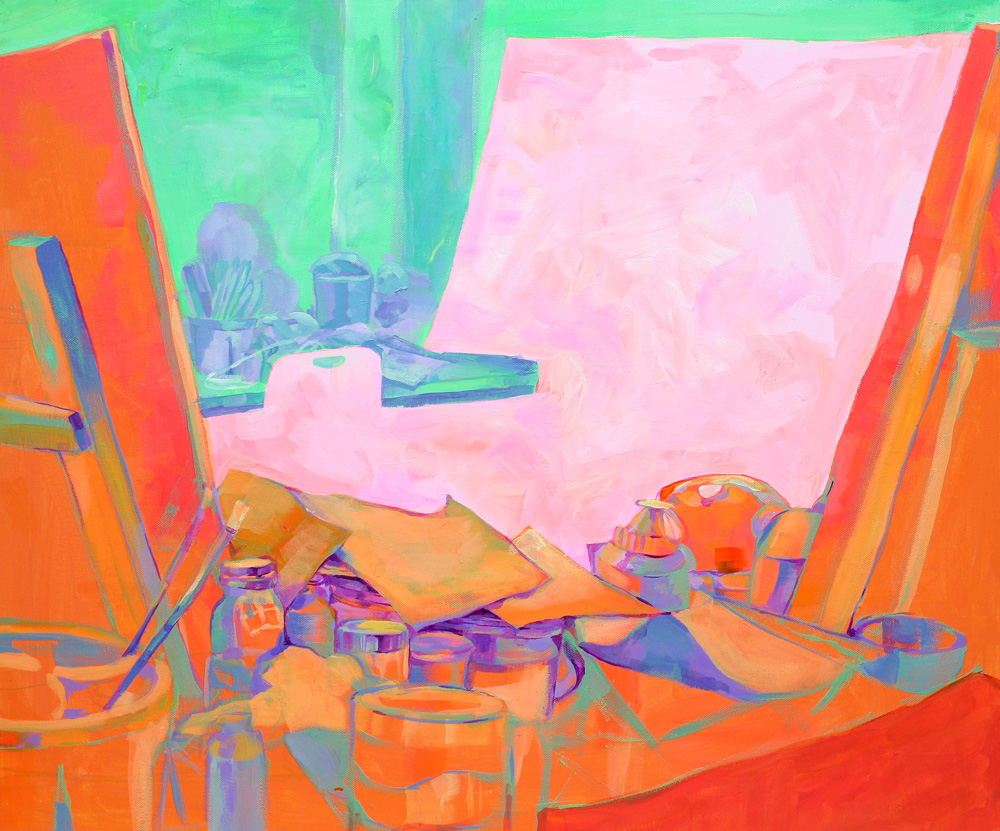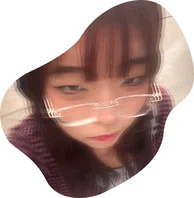

A little happiness in everyday life

Height: 43' x Width: 25' | Material(s): Canvas, acrylic paint, 5th and 7th brushes, marker | Process(es): Using marker for sketch, separate the section in 3 parts, paint with acrylic, put concrete on | Citation(s): Drew directly from my naked eyes; no references | Idea(s): Perspective of my seat in the art studio | Curatorial Note: The color fills and brushwork were a successful solution in transmitting the idea of a fleeting perception of an emotion in the moment.
Gabbi Cho
Student statement
Student statement
Does your work reference or draw on a contemporary or historical artmaking style, practice, or tradition? If so, please explain.
My work draws on the tradition of live art making, a practice rooted in both contemporary and historical approaches to performance art. By creating artwork in real time, I engage directly with the environment and audience, blending spontaneity with intentionality. This method echoes the immediacy of plein air painting and the performative aspects of live demonstrations, fostering a dynamic connection between the artist, the process, and the viewers. Through this practice, I aim to capture the essence of the moment while inviting the audience to witness and participate in the creative journey.
What did you do to improve your 2-D, 3-D, or Drawing portfolio skills?
When drawing something as straightforward as a red apple, I didn’t limit myself to seeing it as just red. Instead, I challenged myself to interpret how that red might appear through my artistic perspective. By experimenting with different colors, I worked to find my unique style and voice as an artist.

Even if I did not draw all of the details of an object, the color in the negative space or the texture of the brush can be used to represent a blurry memory and emphasize the emotions.
In what ways did your artmaking confidence increase in AP Art and Design?
Believing in myself was the biggest factor in increasing my confidence. Even in moments when I doubted my choices or felt uncertain, I reminded myself to trust my instincts and keep trying new things. I also found it important not to confine myself to one style or idea, but to continuously challenge myself by exploring something new. This approach allowed me to grow as an artist and embrace risks without fear.
How did you modify or revise your artmaking direction based on feedback?
I initially didn’t enjoy creating abstract artwork and preferred focusing on detailed, realistic drawings. However, my teacher encouraged me to step back from obsessing over details and approach my work with a lighter, freer mindset. By letting go of some of my perfectionism and focusing solely on my artistic passion, I was able to create pieces that felt more authentic and satisfying. This shift helped me develop a broader perspective on my art-making process.

Bijan Sharifi
Shanghai SMIC Private School
Shanghai, P.R.C.
Teacher statement
Teacher statement
The AP Art and Design course supports inquiry-based personalized learning in the sustained investigation portfolio component.
What strategies helped you guide students through inquiry?
We employed mind mapping ideas, then materials. Afterwards we focused on how the process relates to both. It was a small class, so there was a lot of time to meet with students one-on-one.
How did you scaffold writing into the art-making and thinking processes?
We used the following: arts process journal, reflecting on their works, and planning materials exploration/mixed media. We also outlined steps in their process before they were executed.
How did you support skill development AND inquiry in the AP Art and Design curriculum?
Each student in the class focused on different elements and principles of art and design in their sustained investigation. Students were prompted to reflect on which elements and principles were more prominent in their work and then were asked to research/brainstorm how they could advance their use.
How did you structure practice, experimentation, and revision into your AP Art and Design curriculum?
I encouraged students to work from observation or take reference photos for subjects that challenged their drawing skills. I gave many demonstrations on how to mix media for different purposes, and which surfaces they work best on.
How do you support your students in the Selected Works portfolio component?
Peer critiques helped students receive feedback on which works they should choose. My aim was to structure a safe-space classroom while also facilitating honest discussion.
What formative and summative assessments helped guide your students through your AP Art and Design curriculum?
We utilized progress checks, developed sketches with notes on materials and process, produced mind maps, and documented the process.
What creative programming (i.e., exhibit spaces, mentoring programs, curricular supports) have you implemented to support AP Art and Design students?
We engaged in Zoom calls with professional artists and college art professors, took field trips to galleries, and hosted the yearly AP art show.
What did you learn from working with your student?
I did my best to push her to try new things while also not overstepping beyond her vision.
Is there anything your school leadership does to support your art students or the art program?
We have a good budget for supplies and technology.
What is your advice to other AP Art and Design teachers?
Don’t let students get behind on creating their works.

Danielle Ma'u
Principal
Shanghai SMIC Private School International Division
Pudong New Area, Shanghai, China
Leader statement
Leader statement
What are you most proud of regarding your school’s AP Art and Design program, student, and teacher?
At Shanghai SMIC Private School International Division, our goal is to help each student find their passion. We have a diverse student body in which students leave our school seeking opportunities anywhere from biochemical engineering to set designing. Starting in kindergarten, students are given opportunities to explore their passions, which cultivates a deep love for learning. Our goal is to encourage students to be Motivated Learners; students set high expectations and goals for themselves and are also not afraid to take risks whether they achieve every goal or not. It’s not a drive for perfection but a drive for growth. Our educators pride themselves on building strong relationships with students.
Both Ms. Irina and Mr. Bijan are passionate artists themselves who desire to inspire and help each student to find their creative voice. Vincent van Gogh said, “I am seeking, I am striving, I am in it with all my heart.” That passion, dedication, and enthusiasm is at the heart of learning. This trait was certainly true for Gabbi (Gaeun) Cho. Gabbi knew she wanted to be an artist from the moment she entered SMIC. When Gabbi and her family were seeking a high school that would be just the right fit for them, they chose SMIC specifically for our high caliber and well-rounded art department. During Gabbi’s time here, she was well-known for her creativity and passion. It is no surprise that she is recognized for her art as we know this piece came from the hours and hours that she devoted to harnessing her artistic craft. Well done, Gabbi! We are so proud of you!
What is your advice to other school leaders on how to support an AP Art and Design program?
A key area of having a successful program starts with passionate staff. Having staff who not only love what they do but who also desire to see their students succeed is pivotal for our students. As a school, we see a strong value in supporting the arts. Having space and ample materials for students to feel comfortable and take time to explore their creativity is vital to the success of our program. Our staff knows our students as individual artists, understanding their strengths and areas in which they can continue to develop. As students join our AP course, they are challenged to develop their individual voices.

Gabbi Cho



